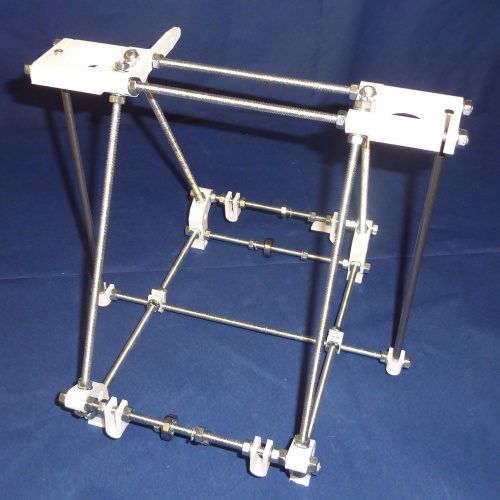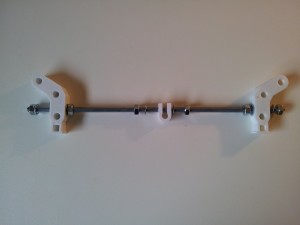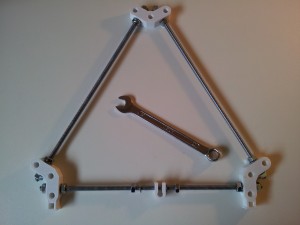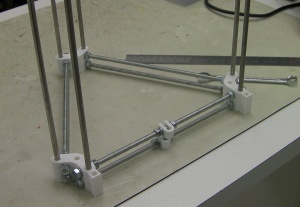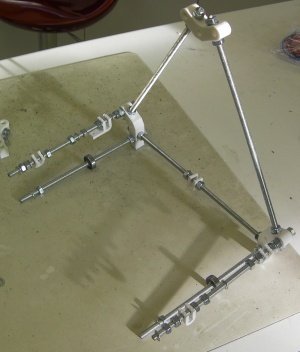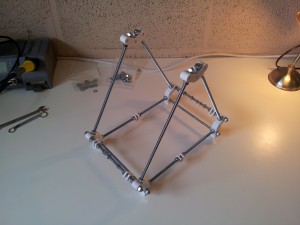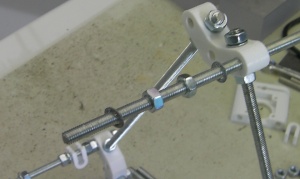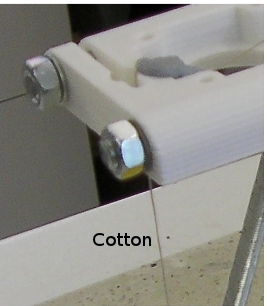Contents
Goal
By the end of this stage, your machine should look like this:
Tools
You will need the following tools
- Laser-cut measurement template (provided with your kit)
- M6 (10mm) spanner
- Adjustable spanner
- Set-square
- 300mm Rule
Frame triangles
| RP parts | Quantity |  |
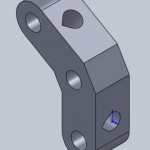 |
2 | |
 |
4 | |
 |
2 | |
| Hardware | Quantity | |
| M6 threaded bar x 250mm | 6 | |
| M6 nuts | 28 | |
| M6 serrated washers | 28 |
Building 2 sets of triangles (5 min each)
Split the above 6x plastic V shape RP components into two equal sets of 3x (1x left part with foot/leg, 1x right part with foot/leg and 1x top part), start with two legs ones, make sure you slide a bar clamp (U shaped plastic part) along the bottom M6 threaded 250mm long bar, with a serrated washer and nut either side, then loosely screw just with force of fingers rest of 250mm rods into each of 3x V shape RP components to finally form a triangle.
When you place a serrated washer between the U shaped RP parts and each M6 nut it will look like this:
Now repeat same for second triangle, you frame triangles should now look like this:
Fine tuning 2 triangle sizes (20 -30 min)
Before moving on to the next step, we need to tighten the nuts in right distance on both frame triangles to make them rigid.
Your kit has a laser-cut measuring template provided. You can use this to make checking the gaps easy. If you do a custom build, best alternative will be to cut a measurement jig 207mm long from 1m long 8mm thick wooden rod.
Please, be patient, give it time, this is very important step.
For each frame, measure the distance between the vertices on all three sides. The distance you should be aiming for is 207mm. But more important is to make them all six the same. The better aligned your frame is, the better your prints will be when printing large and/or tall objects.
Gently tighten all the M6 nuts ensuring the distance between vertices of 207mm is maintained.
A useful trick once you have one triangle accurately tightened is to use other 6mm rods from the kit to align the second one:
Use the 6 smooth rods rather than the threaded ones for better accuracy, but be sure then smooth rods can be inserted without any pressure into holes. In case then you don’t prepare holes well enough and you maintain to push smooth rods inside don’t use any tool on them directly to take them out – take a piece of cloth, wrap them and with screwing like motion take them gently out.
For custom build if you have in hand any M6 hexagon head screws you can use them instead of your expensive smooth rods.
Cross bars
| RP parts | Quantity | 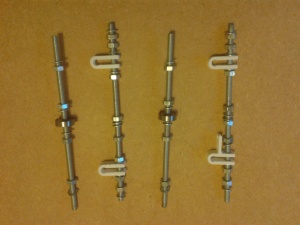 |
 |
3 | |
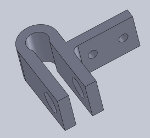 |
1 | |
| Hardware | Quantity | |
| M6 threaded bar x 185mm | 4 | |
| M6 nuts | 24 | |
| M6 serrated washer | 24 | |
| 626 Bearing | 2 |
Again split the above components into two equal sets, but with two U-shaped RP bar-clamps in one set, and one U-shaped RP bar-clamp plus the one with the extra tab in the other. (The tab is for the Y axis limit switch.) You will assemble two top bars (identical but for the U/U+extra-tab), and two bottom bars (identical).
NOTE : The extra tab on one U-shaped bar clamp is used to maintain the Y-axis end-stroke contact. Install it at this moment (see Wiring – step 5 [1]
So for one top bar, you will need (starting from the middle of the M6 threaded bar): serrated washer, two M6 nuts, serrated washer, bar-clamp, serrated washer, two M6 nuts, serrated washer. Then, in the other direction: serrated washer, two M6 nuts, serrated washer, bar-clamp+tab (with the tab facing towards the centre of the bar), serrated washer, two M6 nuts, serrated washer.
For the other top bar, you will need (starting from the middle of the M6 threaded bar): serrated washer, two M6 nuts, serrated washer, bar-clamp, serrated washer, two M6 nuts, serrated washer. Then do exactly the same in the other direction.
And for the bottom bars: 1 x 626 bearing, serrated washer, 2 x M6 nuts, serrated washer, (and repeat in the other direction, except for the bearing).
Your cross bars will now look like this:
Put them all together
| RP parts | Quantity | 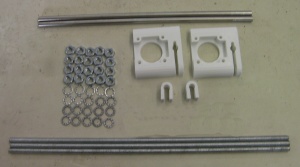 Again, bars aren’t really bent, they are straight! |
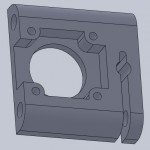 |
2 | |
 |
2 | |
 |
1 | |
| Hardware | Quantity | |
| M6 threaded bar x 285mm | 3 | |
| M6 smooth rods x 235mm | 2 | |
| M6 nuts | 20 | |
| M6 serrated washer | 20 |
Firstly screw the cross bars into one of the triangles. The cross bar with the bar clamp with the extra tab should go at the back, with the bar clamp with the extra tab on the right.
Then screw the second triangle to the other end of the cross bars:
Now we need to slide the two top bars through the top frame vertices. Slide each bar through one vertex, then fit one serrated washer, two M6 nuts and another serrated washer before sliding the bar through the opposite vertex.
Next, slide a Z motor mount onto each ends of the top bars. This may need a little force as the holes through the z motor mounts tend to be quite a tight fit on the M6 threaded bars (it’s usually a good idea to make sure you can push a spare length of M6 threaded bar into each of the z motor mount holes before trying to fit them to your frame).
Add the filament drive bracket so it is inside the left Z motor mount and frame-vertex, and is held against it by the inner nuts and washers. The front slot next to the rounded end goes upwards, the middle slot goes at the back and downwards. Imagine hanging a weight on the projecting end – the slots need to go in the way that makes the weight tend to pull things into place, not to release them.
Before tightening the M6 nuts on the top bars, slide the bottom cross bar through the two bottom bar clamps. You do not need M6 nuts or washers either side of these bar clamps. At each end of this bottom cross bar, fit an M6 nut, a serrated washer, a bar clamp, a serrated washer, and another M6 nut.
At this stage, the frame should be quite loose, so just jiggle everything around until it all the angles look about right. Once you are happy with this step, you can tighten the nuts on the cross bars. The distance between the frame vertices along the cross bars should be 146mm. When tightening the M6 nuts on the top cross bars, please note that you do not need to tighten the nuts which clamp against the Z smooth rods too much, only enough to stop the smooth rod from sliding down. If you slip two washers into the groove on the Z-motor mount (with the threaded rod run through their holes) you will be able to clamp your frame solidly and grip the Z-rods without over-stressing the plastic. Your kit doesn’t come with these washers. 1/4″ washers work well for this.
Before tightening the bar clamps on the bottom cross bar, slide the Y axis smooth rods (270mm) into place. (These are easily confused with the X axis rods, which are 265mm – get the right ones.)
Aligning the Z Rods
Check all of the smooth rods. If the ends of the rods are sharp or burred from cutting, use a file to smooth off the ends to give a small taper/bevel/chamfer; 1mm is fine. Without it, there is a risk of unseating the balls inside linear bearings while inserting the rods.
Check that the linear bearings slide smoothly on each of the smooth rods. The linear bearings may need a little extra oil, and the smooth rod may need cleaning, for smooth running. The quick way to clean the smooth rod is to put it in an electric drill, then use wire wool or a kitchen scourer on it while the drill turns the rod. Be careful though!
You can now slide the two Z smooth rods (length 235mm) into place.
Use a set-square to get the angle of the Z smooth rods correct. Make sure you get the right smooth rod for the Y-axis; if you swap them you will have to go back and take things apart again.
You can now tighten the M6 nuts along the bottom cross bar.
Alternative alignment method
Some people swear by this method, others hate it…
For this you will need the spirit level, two pieces of cotton, and a small blob of Blu-tack.
Build the frame as above, as far as “Aligning the Z Rods”.
Place the frame on a flat surface (40mm-thick Formica-covered kitchen worktops are remarkably flat). You will almost certainly find that the feet aren’t quite level and that the frame rocks a little about a diagonal. Tightening the frame has distorted it slightly.
Put an object about 10mm high under a foot on that diagonal, and very gently push the other two diagonal corners down. Try the feet on the flat surface again. Repeat this until the frame does not rock, but instead sits four-square on the surface. You can carry out this process at any future stage in the build to re-square the frame.
Put the spirit level across the Y smooth bars, and place folded paper shims under the left or right feet until the frame is level left-right. You will discover that a spirit level is an exquisitely sensitive instrument, and that it can easily detect a couple thicknesses of paper.
Rotate the spirit level through a right angle so it rests between the front and back cross bars, and get the frame level front-back too.
Check the frame is level in both directions.
Now thread two lengths of cotton down through the top bracket and the U clamp on the bottom where the Z axis smooth rods will be. Attach it to the Z-axis-smooth-rod holes at the top with Blu-tack such that it is half-way round the inside of the clamp arc.
Put a small blob of Blu-tack on the bottom of each piece of cotton to act as a plumb weight.
Now adjust the positions of the threaded rod at the bottom and the Z-axis-smooth-rod U clamps so that the cotton falls freely in the middle of the U-clamp holes.
Tighten the nuts on the main frame holding the threaded rod, making sure that the cotton stays in the middle of the holes where it was.
Now tighten the inner nuts to move the U clamps outwards so that the cotton just kisses the edge of the U holes in exactly the same relative position as it is falling through the clamps at the top of the frame.
Slide the Z-axis rods in, tighten the clamps from the outside, and check with a square as in the section above. If you’ve done everything carefully there should be little or no discrepancy, but it is more important to have a right angle than to have the Z-rods plumb.
Frame finished
You will now have an assembled RepRapPro Huxley frame:

